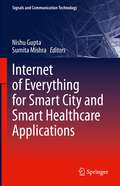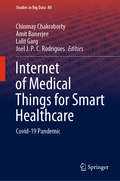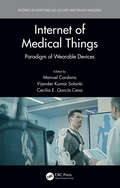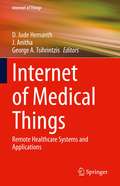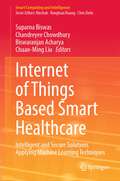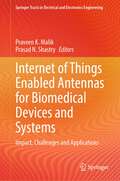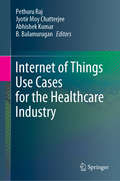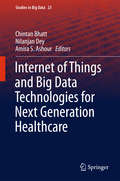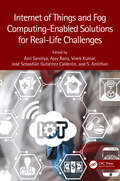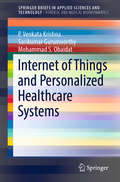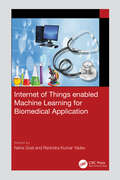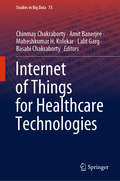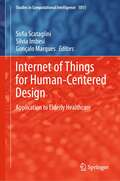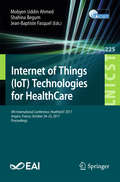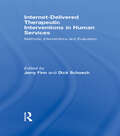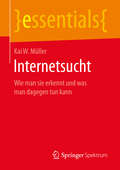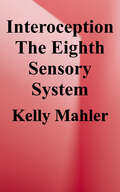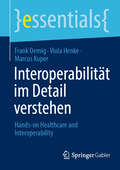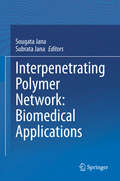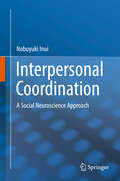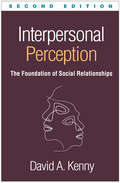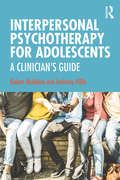- Table View
- List View
Internet of Everything for Smart City and Smart Healthcare Applications (Signals and Communication Technology)
by Nishu Gupta Sumita MishraThis book provides an insight on the importance that the Internet of Things (IoT) and Information and Communication Technology (ICT) solutions can offer towards smart city and healthcare applications. The book features include elaboration of recent and emerging developments in various specializations of curing health problems; smart transportation systems, traffic management for smart cities; energy management, deep learning and machine learning techniques for smart health and smart cities; and concepts that incorporate the Internet of Everything (IoE). The book discusses useful IoE applications and architectures that cater to critical knowledge creation towards developing new capacities and outstanding economic opportunities for businesses and the society.
Internet of Medical Things for Smart Healthcare: Covid-19 Pandemic (Studies in Big Data #80)
by Amit Banerjee Joel J. P. C. Rodrigues Chinmay Chakraborty Lalit GargThis book covers COVID-19 related research works and focuses on recent advances in the Internet of Things (IoT) in smart healthcare technologies. It includes reviews and original works on COVID-19 in terms of e-healthcare, medicine technology, life support systems, fast detection, diagnoses, developed technologies and innovative solutions, bioinformatics, datasets, apps for diagnosis, solutions for monitoring and control of the spread of COVID-19, among other topics. The book covers comprehensive studies from bioelectronics and biomedical engineering, artificial intelligence, and big data with a prime focus on COVID-19 pandemic.
Internet of Medical Things: Paradigm of Wearable Devices (Internet of Everything (IoE))
by Vijender Kumar Solanki Manuel Cardona Cecilia E. GarcíaInternet of Things (IoT) has become a valuable tool for connection and information exchange between devices. This book provides a brief introduction to this new field, focuses on wearable medical devices, and covers the basic concepts by providing the reader with enough information to solve various practical problems. This book provides the latest applications, experiments, fundamentals concepts, and cutting-edge topics for the ehealth and wearable devices field. The book also offers topics related to Security in IoT and Wearable Devices, Wearable Devices and Internet of Medical Devices (IoMT), IoT for Medical Applications, and Tools and study cases. The book brings new and valuable information to PhD researchers, students, professors, and professionals working in IoT and related fields.
Internet of Medical Things: Remote Healthcare Systems and Applications (Internet of Things)
by George A. Tsihrintzis D. Jude Hemanth J. AnithaThis book looks at the growing segment of Internet of Things technology (IoT) known as Internet of Medical Things (IoMT), an automated system that aids in bridging the gap between isolated and rural communities and the critical healthcare services that are available in more populated and urban areas. Many technological aspects of IoMT are still being researched and developed, with the objective of minimizing the cost and improving the performance of the overall healthcare system. This book focuses on innovative IoMT methods and solutions being developed for use in the application of healthcare services, including post-surgery care, virtual home assistance, smart real-time patient monitoring, implantable sensors and cameras, and diagnosis and treatment planning. It also examines critical issues around the technology, such as security vulnerabilities, IoMT machine learning approaches, and medical data compression for lossless data transmission and archiving. Internet of Medical Things is a valuable reference for researchers, students, and postgraduates working in biomedical, electronics, and communications engineering, as well as practicing healthcare professionals.
Internet of Things Based Smart Healthcare: Intelligent and Secure Solutions Applying Machine Learning Techniques (Smart Computing and Intelligence)
by Chuan-Ming Liu Biswaranjan Acharya Chandreyee Chowdhury Suparna BiswasThis book provides both the developers and the users with an awareness of the challenges and opportunities of advancements in healthcare paradigm with the application and availability of advanced hardware, software, tools, technique or algorithm development stemming the Internet of Things. The book helps readers to bridge the gap in their three understanding of three major domains and their interconnections: Hardware tested and software APP development for data collection, intelligent protocols for analysis and knowledge extraction. Medical expertise to interpret extracted knowledge towards disease prediction or diagnosis and support. Security experts to ensure data correctness for precise advice. The book provides state-of-the-art overviews by active researchers, technically elaborating healthcare architectures/frameworks, protocols, algorithms, methodologies followed by experimental results and evaluation. Future direction and scope will be precisely documented for interested readers.
Internet of Things Enabled Antennas for Biomedical Devices and Systems: Impact, Challenges and Applications (Springer Tracts in Electrical and Electronics Engineering)
by Prasad N. Shastry Praveen K. MalikThe book consists of the latest research in biomedical and communication integration. It discusses the fabrication and testing outcomes of the Internet of Things-enabled biomedical applications. The book focuses on recent advances in the field of planar antenna design and their applications in space communication, mobile communication, wireless communication, and wearable applications. Planar antennas are also used in medical applications in microwave imaging, medical implants, hyperthermia treatments, and wireless wellness monitoring. This book presents planar antenna design concepts, methods, and techniques to enhance the performance parameters and applications for IoT and device-to-device communication. It provides the latest techniques used for the design of antennas in terms of their structures, defected ground, MIMO, and fractal design. This book also addresses the specific steps to resolve issues in designing antennas and how to design conformal and miniaturized antenna structures for various applications.
Internet of Things Technologies for HealthCare
by Mobyen Uddin Ahmed Shahina Begum Wasim RaadThis book constitutes the proceedings of the Third International Conference on Internet of Things (IoT) Technologies for HealthCare, HealthyIoT 2016, held in V#65533;ster#65533;s, Sweden, October 18-19, 2016. The conference also included the First Workshop on Emerging eHealth through Internet of Things (EHIoT 2016). IoT as a set of existing and emerging technologies, notions and services provides many solutions to delivery of electronic healthcare, patient care, and medical data management. The 31 revised full papers presented along with 9 short papers were carefully reviewed and selected from 43 submissions in total. The papers cover topics such as healthcare support for the elderly, real-time monitoring systems, security, safety and communication, smart homes and smart caring environments, intelligent data processing and predictive algorithms in e-Health, emerging eHealth IoT applications, signal processing and analysis, and smartphones as a healthy thing.
Internet of Things Use Cases for the Healthcare Industry
by Pethuru Raj Abhishek Kumar Jyotir Moy Chatterjee B. BalamuruganThis book explores potentially disruptive and transformative healthcare-specific use cases made possible by the latest developments in Internet of Things (IoT) technology and Cyber-Physical Systems (CPS). Healthcare data can be subjected to a range of different investigations in order to extract highly useful and usable intelligence for the automation of traditionally manual tasks. In addition, next-generation healthcare applications can be enhanced by integrating the latest knowledge discovery and dissemination tools. These sophisticated, smart healthcare applications are possible thanks to a growing ecosystem of healthcare sensors and actuators, new ad hoc and application-specific sensor and actuator networks, and advances in data capture, processing, storage, and mining. Such applications also take advantage of state-of-the-art machine and deep learning algorithms, major strides in artificial and ambient intelligence, and rapid improvements in the stability and maturity of mobile, social, and edge computing models.
Internet of Things and Big Data Technologies for Next Generation Healthcare
by Nilanjan Dey Chintan Bhatt Amira S. AshourThis comprehensive book focuses on better big-data security for healthcare organizations. Following an extensive introduction to the Internet of Things (IoT) in healthcare including challenging topics and scenarios, it offers an in-depth analysis of medical body area networks with the 5th generation of IoT communication technology along with its nanotechnology. It also describes a novel strategic framework and computationally intelligent model to measure possible security vulnerabilities in the context of e-health. Moreover, the book addresses healthcare systems that handle large volumes of data driven by patients' records and health/personal information, including big-data-based knowledge management systems to support clinical decisions. Several of the issues faced in storing/processing big data are presented along with the available tools, technologies and algorithms to deal with those problems as well as a case study in healthcare analytics. Addressing trust, privacy, and security issues as well as the IoT and big-data challenges, the book highlights the advances in the field to guide engineers developing different IoT devices and evaluating the performance of different IoT techniques. Additionally, it explores the impact of such technologies on public, private, community, and hybrid scenarios in healthcare. This book offers professionals, scientists and engineers the latest technologies, techniques, and strategies for IoT and big data.
Internet of Things and Fog Computing-Enabled Solutions for Real-Life Challenges
by Vivek Kumar Ajay Rana Anil Saroliya Gutiérrez Calderón, José SebastiánIn today’s world, the use of technology is growing rapidly, and people need effective solutions for their real-life problems. This book discusses smart applications of associated technologies to develop cohesive and comprehensive solutions for the betterment of humankind. It comprehensively covers the effective use of the Internet of Things (IoT), wireless sensor network, wearable sensors, body area network, cloud computing, and distributed computing methodologies. The book comprehensively covers IoT and fog computing sensor supported technologies or protocols including web of things, near-field communication, 6LoWPAN, LoRAWAN, XMPP, DDS, LwM2M, Mesh Protocol, and radio-frequency identification. The book- Discusses smart applications to develop cohesive and comprehensive solutions for real-life problems. Covers analytical descriptions with appropriate simulation and prototype models. Examines the role of IoT and fog computing technologies during global emergency situations. Discusses key technologies including cloud computing, 5G communication, big data, artificial intelligence, control systems, and wearable sensors. The text is primarily written for graduate students, and academic researchers working in diverse fields of electrical engineering, biomedical engineering, electronics and communication engineering, computer engineering, and information technology.
Internet of Things and Personalized Healthcare Systems (SpringerBriefs in Applied Sciences and Technology)
by Mohammad S. Obaidat Sasikumar Gurumoorthy P. Venkata KrishnaThis book highlights the issues and challenges in personalised healthcare systems. The individual chapters address different aspects of such systems, including the novel Internet of Things (IoT) system architectures in healthcare and emerging e-health based IoT applications. Moreover, the book investigates the impact of cutting-edge innovations on the IoT.
Internet of Things enabled Machine Learning for Biomedical Application
by Neha Goel Ravindra Kumar YadavThe text begins by highlighting the benefits of the Internet of Things-enabled machine learning in the healthcare sector, examines the diagnosis of diseases using machine learning algorithms, and analyzes security and privacy issues in the healthcare systems using the Internet of Things. The text elaborates on image processing implementation for medical images to detect and classify diseases based on magnetic resonance imaging and ultrasound images.This book:· Covers the procedure to recognize emotions using image processing and the Internet of Things-enabled machine learning.· Highlights security and privacy issues in the healthcare system using the Internet of Things. · Discusses classification and implementation techniques of image segmentation.· Explains different algorithms of machine learning for image processing in a comprehensive manner. · Provides computational intelligence on the Internet of Things for future biomedical applications including lung cancer.It is primarily written for graduate students and academic researchers in the fields of electrical engineering, electronics and communications engineering, computer science and engineering, and biomedical engineering.
Internet of Things for Healthcare Technologies (Studies in Big Data #73)
by Amit Banerjee Maheshkumar H. Kolekar Chinmay Chakraborty Lalit Garg Basabi ChakrabortyThis book focuses on recent advances in the Internet of Things (IoT) in biomedical and healthcare technologies, presenting theoretical, methodological, well-established, and validated empirical work in these fields. Artificial intelligence and IoT are set to revolutionize all industries, but perhaps none so much as health care. Both biomedicine and machine learning applications are capable of analyzing data stored in national health databases in order to identify potential health problems, complications and effective protocols, and a range of wearable devices for biomedical and healthcare applications far beyond tracking individuals’ steps each day has emerged. These prosthetic technologies have made significant strides in recent decades with the advances in materials and development. As a result, more flexible, more mobile chip-enabled prosthetics or other robotic devices are on the horizon. For example, IoT-enabled wireless ECG sensors that reduce healthcare cost, and lead to better quality of life for cardiac patients. This book focuses on three current trends that are likely to have a significant impact on future healthcare: Advanced Medical Imaging and Signal Processing; Biomedical Sensors; and Biotechnological and Healthcare Advances. It also presents new methods of evaluating medical data, and diagnosing diseases in order to improve general quality of life.
Internet of Things for Human-Centered Design: Application to Elderly Healthcare (Studies in Computational Intelligence #1011)
by Sofia Scataglini Gonçalo Marques Silvia ImbesiThe book presents the state of the art of the Internet of Things (IoT), applied to Human-Centered Design (HCD) projects addressed to ageing users, from the perspective of health, care and well-being. The current focus on the ageing population is opening up new opportunities for the development of niche solutions aimed at the niche category of older users who are beginning to experience physical and cognitive decline but are still independent and need to maintain their autonomy for as long as possible. The combination between the needs expressed by older users and the opportunities offered by the recent innovative technologies related to the Internet of Things allows research institutions, stakeholders, and academia to target and design new solutions for older users, safeguarding their well-being, health, and care, improving their quality of life. This book discusses and analyses the most recent services, products, systems and environments specifically conceived for older users, in order to enhance health, care, well-being and improve their quality of life. This approach is coherent with the percept of AAL or enhanced living environment, looking to the users’ comfort, autonomy, engagement and healthcare. The book describes and analyses aspects of HCD with older users looking to the emerging technologies, products, services, and environments analysed in their actual application in different areas, always concerning the design for the elderly related to the IoT, just as the development of biomonitoring devices, tools for activity recognition and simulation, creation of smart living environments, solutions for their autonomy, assistance and engagement enhancing health, care and wellbeing. The book is intended for researchers, designers, engineers, and practitioners in healthcare to connect academia, stakeholders, and research institutions to foster education, research and innovation.
Internet of Things: 4thd International Conference, Healthyiot 2017, Angers, France, October 24-25, 2017, Proceedings (Lecture Notes of the Institute for Computer Sciences, Social Informatics and Telecommunications Engineering #225)
by Mobyen Uddin Ahmed Shahina Begum Jean-Baptiste BastelThis book constitutes the proceedings of the Fourth International Conference on Internet of Things (IoT) Technologies for HealthCare, HealthyIoT 2017, held in Angers, France, in October 2017. The IoT as a set of existing and emerging technologies, notions and services can provide many solutions to delivery of electronic healthcare, patient care, and medical data management. The 17 revised full papers presented were carefully reviewed and selected from 23 submissions. The papers cover topics such as healthcare support for the elderly, real-time monitoring systems, security, safety and communication, smart homes and smart caring environments, intelligent data processing and predictive algorithms in e-Health, emerging e-Health IoT applications, signal processing and analysis , the smartphones as a healthy thing, machine learning and deep learning, and cloud computing.
Internet-Delivered Therapeutic Interventions in Human Services: Methods, Interventions and Evaluation
by Jerry Finn Dick SchoechThere has been exponential growth in use of the Internet to deliver therapeutic and supportive human services. Online interventions are known by a variety of names, including online practice, e-therapy and others. All refer to the delivery of services over the Internet through a variety of delivery systems including asynchronous email, video and chat communication, and closed-circuit video conferencing. They include services delivered by professionals such as psychiatrists, social workers, psychologists, counsellors and nurses as well as self-help groups with a therapeutic purpose and supportive services provided by trained volunteers.This book presents the most current research on online practice. Topics include: descriptions of innovative online practice, evaluation studies of online practice with specific disorders, meta-analysis of the effectiveness of online practice, education and training of online practitioners, methods for the delivery of online practice, organizational policy and ethical issues related to online practice, online crisis intervention and hotline services, and considerations for meeting legal and ethical requirements of online practice. This book was originally published as a special issue of the Journal of Technology in Human Services.
Internetsucht: Wie man sie erkennt und was man dagegen tun kann (essentials)
by Kai W. MüllerKai W. Müller erläutert in diesem essential Hintergründe rund um das Phänomen der Internetsucht. Auf übersichtliche Art und Weise wird erklärt, was man unter Internetsucht versteht, welche Erkennungsmerkmale herangezogen werden, wie verbreitet dieses noch junge psychische Krankheitsbild ist und welche Hilfsangebote zur Verfügung stehen. Der Leser erhält zudem einen umfassenden Einblick in mögliche Ursachen für die Entstehung dieser Suchtproblematik.
Internistische Intensivmedizin für Einsteiger
by Johann Auer Dietmar ReitgruberDas vorliegende Werk liefert das Basiswissen für die Versorgung des internistischen Intensivpatienten – systematisch dargestellt, verständlich erklärt und mit vielen konkreten Tipps. Es wendet sich an Assistenzärzte in der Inneren Medizin, die im Rahmen ihrer Facharztweiterbildung auf die Intensivstation rotieren müssen und eine erste Anleitung für die Arbeit auf der Intensivstation benötigen. Dargestellt werden allgemeinen Prinzipien, wie apparative Diagnostik, Ernährung und Gerinnungsmanagement über spezielle Interventionen, wie Gefäßpunktionen, Schrittmacheranlage und Analgosedierung bis hin zum konkreten Vorgehen bei häufigen intensivpflichtigen Krankheitsbildern und Akutsituationen, wie akutes Koronarsyndrom, Herzrhythmusstörungen, ARDS und Intoxikationen. Ein praxisnahes Werk, mit dem der Einstieg in die internistische Intensivmedizin gelingt.
Internship Survival Guide (The\washington Manual Ser.)
by Thomas M. De FerPublisher's Note: Products purchased from 3rd Party sellers are not guaranteed by the Publisher for quality, authenticity, or access to any online entitlements included with the product. Substantially revised since the previous edition, this Internship Survival Guide offers first-year residents practical, real-world medical and professional guidance from senior residents and faculty advisors at the Washington University School of Medicine. Advice is presented in a concise, bulleted format, lending itself to quick comprehension of the material. You’ll learn the nuts and bolts of logistical issues and patient and colleague communication, as well as the basics of navigating your clinical rotations.
Interoception: The Eighth Sensory System
by Kelly MahlerInteroception, a newly identified eighth sense, allows us to "feel our internal organs and skin and gives information regarding the internal state or condition of our body." As such it is also a key component of our emotional experience. This is an area of difficulty for many, including those with autism spectrum disorders. <p><p>The book reviews the research underlying the effects of poor interoception and outlines strategies for how to ameliorate these effects.--Publisher
Interoperabilität im Detail verstehen: Hands-on Healthcare & Interoperability (essentials)
by Frank Oemig Viola Henke Marcus KuperDieses essential bietet einen Einstieg in die Fragestellung, was mit dem Begriff „Interoperabilität“ gemeint ist, der nicht nur den Datenaustausch zwischen IT-Systemen im Gesundheitswesen beschreibt. Dazu werden die in diesem Kontext häufig gebrauchten Begriffe wie Kompatibilität oder Konformität erläutert und in einen Zusammenhang gebracht. Weiterhin wird aufgezeigt, dass Interoperabilität das Ergebnis eines längeren Arbeits- und Austauschprozesses ist und wie „Interoperabilität“ für den erfolgreichen und reibungslosen Einsatz im Gesundheitssystem gemeinsam mit allen Stakeholdern weiterentwickelt werden kann.
Interpenetrating Polymer Network: Biomedical Applications
by Sougata Jana Subrata JanaThe book focuses on novel interpenetrating polymer network (IPN)/semi-IPN technologies for drug delivery and biomedical applications. The dynamism of the design and development of interpenetrating network polymers is based on their ability to provide free volume for the easy encapsulation of drugs in the three-dimensional network structure obtained by cross-linking two or more polymer networks. Natural polymer-based IPNs can deliver drugs at a controlled rate over an extended period of time, while novel IPNs ensure better mechanical strength and sustained/ controlled drug-delivery properties. This book presents an overview of the use of this technology to fabricate nanomedicine, hydrogels, nanoparticles, and microparticles, thereby unlocking IPN’s potential in the area of drug delivery and biomedical engineering. It also discusses applications of IPN systems in cancer therapy and tissue engineering, and describes the various IPN systems and their wide usage and applications in drug delivery.
Interpersonal Coordination: A Social Neuroscience Approach
by Nobuyuki InuiThis book explores the fascinating area of interpersonal coordination in force production tasks, outlining the author’s extensive research to date and presenting stimulating new perspectives. The purpose is to provide a detailed exposition of current understanding of the science behind interpersonal joint action. Readers will find clear explanation of concepts from social cognition and neuroscience that are key to an understanding of the field, including the social brain hypothesis, the mirror neuron system, and joint action, as well as other relevant background information. The author then proceeds to present an overview of recent original studies on interpersonal movement coordination performed at his laboratory in Japan. These studies provide insights into such issues as complementary and synchronous force production in joint action, bidirectional transfer between joint and solo actions, and motor control hierarchy in joint action involving bimanual force. They also set the direction for integration of knowledge of physical properties and social cognition. The book will be of interest for researchers and graduate students in all areas of the biomedical sciences.
Interpersonal Perception, Second Edition: The Foundation of Social Relationships
by David A. KennyPeople make judgments about others all the time, often without realizing they are doing so. How are interpersonal impressions formed? How accurate are our perceptions of other people's traits--and our own? In this major revision of his landmark work, David A. Kenny provides a reader-friendly examination of these and other critical questions, identifying key components that shape impressions and their accuracy. Topics include how to estimate perceiver, target, and relationship effects; the extent to which different perceivers see a target in the same way; the impact of group membership and stereotypes; and whether others see us as we see ourselves. Implications for interpersonal relationships and social behavior are highlighted. New to This Edition *Virtually a new book; incorporates 25 years of theoretical, empirical, and methodological advances. *New and greatly expanded topics, including first impressions, individual differences in accuracy, implicit measures, and narcissism. *Grounded in a reformulated conceptual model. *More accessible--uses nontechnical language, humor, popular culture, and simplified figures to elucidate complex ideas. *End-of-chapter "Practical Suggestions" apply the science to real-world social situations.
Interpersonal Psychotherapy for Adolescents: A Clinician’s Guide
by Robert McAlpine Anthony HillinInterpersonal psychotherapy for adolescents (IPT-A) is a comprehensive guide for clinicians. It will enable readers to add IPT-A to their clinical repertoire or to deepen their existing practice of IPT-A, using a time-limited, evidence-based intervention that is engaging for young people. The guide outlines the structure, skills, and techniques of IPT-A, utilising real-life encounters in the therapy room that reflect the diverse nature of adolescents and young adults who present for therapy. It provides the reader with a bird's-eye view of how IPT-A works. It expands the range of IPT-A clinical tools, techniques, and models to assist the reader to work effectively with a wide range of clients. The book provides a new protocol for the psychological assessment of young people, acknowledging the importance of culture and spirituality alongside the biological, psychological, and social dimensions that have previously comprised assessment. The importance of the clinician forming a transitory attachment relationship with the client is emphasised throughout. The target audience for this book is mental health clinicians, including psychologists, psychiatrists, social workers, mental health nurses, occupational therapists, general practitioners with a mental health focus, and students from these professions.
